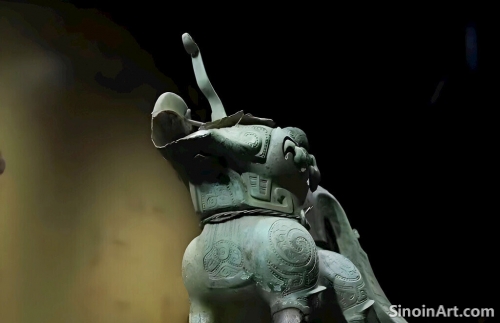Bronze Ware and the Development of Ancient Chinese Maritime Trade: Ship Fittings and Navigation Tools
|
While often associated with inland power and ritual, bronze also played a crucial role in the development of ancient Chinese maritime trade, used to create ship fittings, navigational instruments, and other tools that were essential for long-distance seafaring and the exchange of goods. The connection between bronze and maritime trade highlights the ingenuity of ancient Chinese engineers and their deep understanding of the forces of nature and also the value that was placed on maritime trade.  Bronze was used to create durable and reliable components for ships and boats, including anchors, rudders, and reinforcement fittings, which helped to increase both safety and effectiveness of the vessels during long sea journeys. The ability of bronze to withstand the rigors of the sea made it an essential component of shipbuilding. The use of these bronze fittings helped to improve the overall safety and reliability of vessels for trade and exploration.  Bronze was also used to create instruments for navigation, including compasses, sighting devices, and charts, which were essential for plotting courses, avoiding hazards, and exploring new territories. The creation of accurate maps and navigational devices helped to facilitate new forms of trade and also helped to expand the understanding of the world for the people of the time.  The trade of bronze objects themselves also fueled the development of maritime routes, with bronze vessels, mirrors, and other artifacts being exchanged for goods from other regions, highlighting the important role that bronze played as both a medium of artistic expression and also as a key component of international trade. The value of these artifacts made them powerful trade items. The ability to use bronze for many purposes helped to create an interconnected global economy. |
Tag : bronze maritime trade, Chinese navigation, shipbuilding tools, ancient sea routes, maritime technology
Related information
- The Bronze Masks of Sanxingdui: Exploring Ritual, Transformation, and the Unseen Realm
- The Social and Political Symbolism of Bronze Weapons: Power, Authority, and Military Might
- The Evolution of Bronze Mirror Design: From Early Simplicity to Ornate Patterns and Narrative Scenes
- The Production and Use of Bronze in the Ancient Kingdom of Shu: The Uniqueness of Sanxingdui
- The Influence of Bronze Ware on Later Chinese Decorative Arts
This article delves deeper into the bronze masks of Sanxingdui, exploring their unique characteristics, their role in ritual performances, their connection to the spirit world, and the insights they provide into the distinct religious beliefs of the ancient kingdom of Shu.
This article explores the social and political symbolism of bronze weapons in ancient China, highlighting their connection to power, authority, and military might, and demonstrating how the possession and display of these objects reflected status and leadership.
This article explores the evolution of bronze mirror design in ancient China, highlighting the shift from simple forms to more complex designs, including the use of intricate patterns, symbolic imagery, and narrative scenes, demonstrating the interplay between art, technology, and cultural change.
This article explores the bronze ware of the ancient kingdom of Shu, highlighting the unique artifacts discovered at Sanxingdui, the distinct casting techniques, and the cultural significance of this powerful and largely independent civilization.
This article explores the influence of bronze ware on later Chinese decorative arts, highlighting its impact on forms, motifs, and aesthetic principles, and demonstrating the enduring legacy of bronze design across various art media.